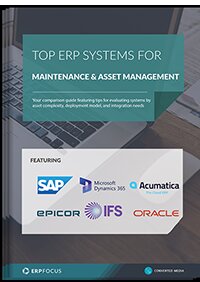How to evaluate Microsoft Dynamics 365 integration readiness
When businesses adopt new software (whether to support a growing department, replace aging systems, or through acquisition), it’s easy to assume integration with Microsoft Dynamics 365 will be straightforward. After all, the platform is built to integrate. But readiness isn't automatic.
In reality, successful integrations depend on the right technical fit, clear process mapping, and proactive planning. Whether you’re preparing for a CRM integration, syncing marketing tools like HubSpot, or integrating financial systems post-acquisition, assessing integration readiness should be an early and essential part of your ERP strategy.
To help, we’ve developed a practical checklist that ERP teams can use to evaluate software integration potential before committing to a full rollout. But first, let’s break down when and why to use it.
Key considerations
IT leaders should address several technical and organizational factors to assess integration readiness. Such an undertaking affects your data quality, user adoption, and long-term ERP performance. These scenarios in particular warrant a formal review:
- Adding new third-party tools such as CRMs, marketing platforms, or procurement tools.
- Replacing or customizing legacy systems that still hold key operational data.
- Expanding into new business areas or international operations that use different platforms.
- Acquiring a company or project with its own stack of software (e.g., a sales team using another CRM).
One business we spoke to (a large enterprise managing complex acquisitions) shared how new acquisitions often came with legacy software. To avoid disruption and ensure cohesion with their Dynamics environment, their approach involves a structured checklist to vet software for integration suitability before onboarding it. That’s the kind of foresight every ERP project needs.
Questions to guide your integration assessment
Every ERP environment is different, but these foundational questions can help you quickly assess how compatible a given software system is with your D365 setup:
- What type of data needs to flow between systems? (Customers, orders, financials, etc., and in which direction?)
- How frequently does the data need to sync? (Real-time, near real-time, or batch?)
- Does the software offer open APIs or native connectors? Dynamics 365 integrates well with REST APIs, Dataverse, and the Microsoft Power Platform, but third-party systems must cooperate.
- Is the software hosted on-premises or in the cloud? Hybrid environments may require additional middleware or firewall configuration.
- Are there regulatory or compliance considerations? Security models, data residency, and audit trails need to align across platforms.
Common Dynamics 365 integration scenarios
To ground this assessment in real-world use cases, here are some typical integration patterns seen across ERP environments:
HubSpot and Dynamics 365 integration
Organizations often use HubSpot for marketing while managing sales in Dynamics 365 CRM (naturally, compatible with the wider D365 suite) or Business Central. Integration can keep lead, contact, and activity data consistent between systems if the sync is configured properly. HubSpot offers a pre-built connector, but mapping custom fields and workflows still requires thoughtful setup.
Be sure to validate system compatibility: e.g., older Dynamics CRM versions have reached end-of-life, and Microsoft encourages moving to D365 Sales. If the project includes a legacy CRM, check support dates and consider whether an integration or an outright upgrade is more cost-effective.
Legacy system integration
Businesses with long-standing systems often want to integrate Dynamics 365 Finance while keeping their old ERP running temporarily. This scenario demands clear documentation, API compatibility checks, and often a middleware layer to standardize data formats.
Multi-CRM environments
In post-acquisition scenarios, new teams might be using other CRMs (like Salesforce or Zoho). Before switching systems, integration may be required to maintain visibility across pipelines. Evaluate whether real-time sync is necessary or if scheduled imports will suffice.
Choosing the right approach
D365 supports a range of integration methods, depending on your needs and technical environment:
| Approach | Use case |
|---|---|
| Native connectors | For well-known platforms like HubSpot or SharePoint |
| Power Automate / Logic apps | For low-code workflows and quick integrations |
| Dataverse | When connecting apps within the Microsoft ecosystem |
| Custom API development | For highly specific or legacy integrations |
| Middleware / iPaaS | For managing multiple integrations across platforms |
Tip: Don’t confuse availability with suitability. Just because a connector exists doesn’t mean it handles your unique data or process requirements.
Best practices for D365 integration
Over time, ERP teams have shared consistent lessons about system integration that carry over to Dynamics 365 projects:
-
Clean your data first: Poor-quality data from other systems can pollute your Dynamics environment.
-
Start small: Pilot your integration in a low-risk area before scaling.
-
Document everything: Field mappings, decision points, and limitations should be recorded for future audits and troubleshooting. This is often overlooked but pays dividends when scaling the solution at a later date.
-
Avoid over-customizing too early: Use out-of-the-box options until needs are proven.
-
Prioritize critical processes: Not every data exchange needs instantaneous integration. Identify essential integrations (those needed to keep the business running immediately after acquisition, such as a finance API for invoices) versus longer-term links (e.g., integrating a new e-commerce site). A phased approach can get core functions live first while refining others.
-
Train users on integrated workflows: Even the best technical setup can fail without adoption.
-
Test rigorously: Before go-live, simulate transaction flows end-to-end. For instance, create a test customer order in the acquired system and verify that it correctly creates the corresponding records in D365 (and vice versa). Automate testing where possible, and include volume/performance tests to ensure new integrations won’t bottleneck the system.
-
Engage vendors or partners: If the acquired software is a third-party ERP or niche system, involve its vendor. Many vendors offer guidance or even integration accelerators for connecting to Dynamics 365. If an internal skill gap exists, consider an integration partner experienced in Dynamics projects.
Final thoughts
Microsoft Dynamics 365 is built to be flexible, scalable, and open. But it’s only as effective as the planning behind it. Project managers must think beyond whether an integration can happen and instead ask: Should it? How? What will it affect?
Whether you're merging systems, deploying new tools, or replacing outdated software, this approach will help protect the integrity of your ERP and accelerate time-to-value.
Start with this checklist, align with your technical team, and plan from a position of clarity.
Looking for more integration guidance? Read our full beginner’s guide to ERP integration.
Free white paper

Microsoft Dynamics 365 integration readiness checklist
Get your free, practical checklist to assess whether third-party or legacy systems are ready to integrate with Dynamics 365

Featured white papers
-

Top ERP Software for Maintenance & Asset Management
Compare ERP systems with CMMS and EAM capabilities to manage your assets smarter
Download -

Microsoft Dynamics 365 integration readiness checklist
Get your free, practical checklist to assess whether third-party or legacy systems are ready to integrate with Dynamics 365
Download
Related articles
-

Distribution ERP vs WMS: which suits your needs better?
Distribution ERP vs WMS: be clear on the differences with this guide
-

Secret KPI: Why Your ERP Implementation Team Matters More Than Software
Learn how Godlan ensures successful ERP implementation for manufacturers with proven strategies &...
-

A beginner’s guide to ERP integration
What is ERP integration, why it matters, and more!

